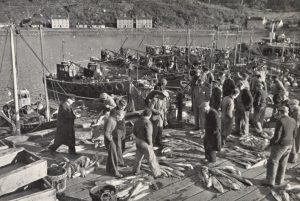Since 2021, photographer and historical researcher Estelle Slegers Helsen has been wandering around Lochaber in the footsteps of the Scottish photographer W.S. Thomson MBE (1906-1967). She takes photographic remakes roughly 70 years after Thomson initially captured the landscape and talks to local people along her journey. Every fortnight, Estelle takes our readers to various places in Lochaber. This week, she focuses on Mallaig Harbour.

W.S. Thomson’s photograph Auctioning the night’s catch at Mallaig Pier captured around 1950, is an atypical image published in his booklet Let’s See Mallaig and the Road to the Isles.
As a landscape photographer, he focused on the glens, lochs, hills, mountains and clouds and avoided capturing people in his frame.
However, this photograph, in which two dozen people play a part, perfectly concludes the photographic journey from Glenfinnan to Mallaig, depicting Mallaig as a busy fishing port.
“As a village, Mallaig is a relatively recent creation,” explains Malcolm Poole, the
Mallaig Heritage Centre curator.
“In the 1840s, Lord Lovat, the owner of North Morar Estate, divided the farm of Mallaigvaig into 17 parcels of land and encouraged his tenants to move to the western part of the peninsula to make a living from fishing.”
Fishing was a hazardous business in the 19th century.
Regardless, by 1851, more than 100 people settled on the rough and windy plots of Mallaig, which became the largest settlement on the peninsula.
“The steady growth of Mallaig as a harbour began with the building of the first pier in 1846 by Lord Lovat,’ adds harbour master James “Pimmy” McLean.
Ever since, Mallaig has been synonymous with fishing, particularly with the west of
Scotland herring fishery, which made it the largest herring port in Europe during
the 1960s and 1970s.
In the introduction of Let’s See Mallaig and the Road to the Isles, Wendy Wood
describes the village as a place dominated by gulls: “At first glance, Mallaig might be judged ugly and uninteresting and mainly populated by gulls.
“Every islet is white with gulls, every gable, fence, flagstaff and roof has its decoration of portly white seabirds.”
She continues: “Mallaig is mainly a harbour.
“In that basin lie boats of all sorts and sizes, that come and go like buses from a bus terminus.
“Boats being repaired, repainted, even a-building. Boats ashore, boats afloat, from dinghies and fishing smacks (a traditional fishing boat with sails) to MacBrayne’s steamers…”
Thomson has captured a busy morning on the harbour quay.
In the middle are the local herring boats. The Mansons, a fishing family, owned five of them.
From her recollection, Mary Michie (née Manson) names a few family members and other people. “The man on the left is Mr Kennedy, who worked at the railway.
“I think my father is the fourth person from the left in the darker jersey, speaking to Bruce Watt.
“Further to the right, in front with the longer dark coat, is Uncle Jim Addison, and behind, I recognise Uncle Jim Manson and Cousin Jimmy Manson.”
The image of the harbour structure, mainly built of wood, completely changed in 1972.
The fish pier on the right of the photograph, hidden behind more than a dozen fishing boats, was extended with a concrete structure.
The old pier is still underneath the new one. The wooden harbour floor was heightened with concrete and built eight feet further out.
A fish sales hall was built, so the trade in the open air had become history.
By the mid-1970s, Mallaig had plunged into darkness.
Pimmy said: “Fish stocks suffered from years of overfishing and a four-year ban on herring fishing was imposed.
“It was a struggle to get the markets back. The Mallaig fleet turned to alternative
catches, such as mackerel and whitefish.
“Today, we are a leading port for prawn landings on the Scottish west coast.”
From his first-floor office, Pimmy points to where Thomson has taken the photograph.
The remaining reference points are the buildings in the background along East Bay. The houses and the three blocks of flats were built in the 1920s when the road to Mallaigvaig was widened.
There were more than 50 locally owned fishing boats in the heydays, and now there are five.
All the goods in front are temporarily stored at the quay, coming from or going to the small isles, such as Rum or Eigg, and Inverie on the Knoydart peninsula across Loch Nevis.
As I walk along the harbour and go into the neighbouring streets in the village, seagulls remain part of the scenery. Even though the birds leave a less distinctive mark.
More prominent are the tourists from Fort William who have taken the trendy Jacobite train to Mallaig.
During the day, they populate the coffee shops, restaurants and souvenir shops. Sitting on the benches and low walls, they eat fish and chips or lick ice cream.
And once in a while, amidst general hilarity, an alert seagull scoops a bite of the meal of a distracted tourist.
- Travel in Time – Lochaber Series was supported by the West Highland
Museum and the Year of Stories 2022 Community Fund. Estelle has published a
64-page book with 30 side-by-side then-and-now pictures, which you can find
in local shops or buy online – www.travelintime.uk